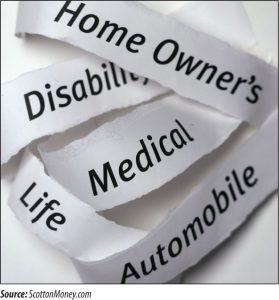 There many circumstances that could be financially devastating to you and your family’s financial well-being. For example, in the event of a fire, theft, law suit, or natural disaster you would want to recover your losses and remain financially secure. Statistics show that 51% of insurance claims are not covered because of changes in life events and the subsequent failure to review outstanding insurance protection. With that in mind, the following are the most common coverage’s people overlook.
There many circumstances that could be financially devastating to you and your family’s financial well-being. For example, in the event of a fire, theft, law suit, or natural disaster you would want to recover your losses and remain financially secure. Statistics show that 51% of insurance claims are not covered because of changes in life events and the subsequent failure to review outstanding insurance protection. With that in mind, the following are the most common coverage’s people overlook.
1. Life Insurance: Ben Franklin once said the only two things in life you can count on are death and taxes. Most people buy a life insurance policy and file it away, never to be looked at again. In the meantime, beneficiaries may require updating, the amount of insurance might need to be adjusted, or the policy cash value could run out. You should review existing life insurance periodically because your life changes and consequently your insurance needs change.
2. Umbrella Liability: This is one of the most overlooked policies for people who maintain a higher net worth. This type of policy protects your assets and future income beyond the standard limitations of your primary liability policies. Typically, umbrella policies are in increments of $1 million and provide protection beyond standard home, car, and boat plans. An umbrella liability policy is highly recommended for people who have a net worth above the standard limitations.
3. Broadened Coverage for Expensive items: If you have expensive items, your homeowner’s policy may be inadequate. Items such as jewelry, collectibles, fine art, and musical instruments may exceed the limits of standard homeowner coverage.
- Jewelry Coverage: Every home insurance policy places a limitation on jewelry. Most policies only include $1,000 of coverage, which does not cover a common loss known as “mysterious disappearance” (i.e., stone falling out of ring). Listing your jewelry items individually is the best way to ensure that items are insured up to the specified dollar amount.
- Coverage for Collectibles: Every home policy has a special limitation on collectibles like coins, stamps, and baseball cards. Listing your collectibles separately may be a good idea because some collectibles are not covered under the standard policy. Coverage may be modified to include “All Risk Coverage”, which would cover breakage, mysterious disappearance, and other perils not normally covered under personal property.
4. Replacement Cost on Dwelling and Personal Property: This type of coverage guarantees the dwelling or personal property will be replaced, without depreciation, in the event of a loss. Replacement cost, not market value (what you could currently sell your home for) is the benchmark used to insure your dwelling.
5. Identity Theft Coverage: Identity theft is the fastest growing crime in America. This type of coverage reimburses you for expenses related to restoring your identity if it were stolen. Most homeowners policies offer identity theft coverage, but as an endorsement for an additional charge.
6. Business in the Home Endorsement: In today’s world many people operate businesses out of their home. This type of coverage provides liability and/or business property coverage for certain home-based businesses. If a business client is injured on your property a standard home policy may not pay for the loss. Therefore, you need separate coverage. Make sure you include your home business inventory.
7. Flood Insurance: Flood coverage is not provided on a traditional homeowner’s policy. It is a separate policy that would need to be provided. It affords coverage from an overflow of a body of water and/or surface water. You do not need to be in a flood prone area to purchase a flood policy and may want to consider this type of coverage if you are concerned about the potential for surface water damage.
8. Drain/Sewer Backup: Most homeowner’s insurance policies don’t automatically include coverage for damage caused to your home (typically your basement) due to sewage backing up or rainwater that floods in due to the failure of your sump pump. If you have a finished basement this coverage may be especially important. Even without a finished basement you could have damage to your furnace, water heater, or water softener and this coverage would apply.
9. Recreational Vehicle Coverage: Many consumers are unaware that coverage can be added to a variety of recreational vehicles including boats, ATVs, snowmobiles, golf carts, etc. This is a type of policy people with higher-value recreational vehicles should certainly consider.
10. Loan/Lease: Loan/Lease covers the difference between the amount owed on lease or loan and the amount normally paid by a car insurance policy at the time of a total loss. For example, if your vehicle were totaled in an accident the insurance company, for several reasons, may not pay the entire value of an outstanding loan. Loan/lease insurance would cover the additional value not paid.
[author] [author_image timthumb=’on’]https://sensenigcapital.com/wp-content/uploads/2012/03/meschter.jpg[/author_image] [author_info]George W. Meschter is President of Meschter Insurance Group, and started out from a young age learning about the insurance business from his father. Today he attends to the insurance needs of larger commercial accounts, and keeps abreast of changes in the broader insurance industry. He is a founding member of Premier Insurance Network, an insurance consortium. He also serves on local boards, including the Schwenkfelder Library, Harleysville Savings Bank, and the Perkiomen Schoool. For more information on his firm click here.[/author_info] [/author]


